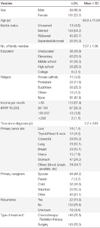Abstract
Purpose
This study was designed to describe outcomes of pain management, to identify pain intensity, pain management and barriers to pain management, and to test correlation among the variables in cancer patients who are registered in public health centers.
Methods
By using a descriptive survey design, 3 instruments were used to collect data: the Numeric Rating Scale for pain, the Barriers Questionnaire-Korean version, and a one-item self-report tool about patient satisfaction. A sample of 190 patients with cancer was recruited from a public health center.
Results
The mean rating for pain during the past 24 hr was mild and the mean score of barriers to pain management was 3.20. Patients were satisfied with pain management but they also had concerns it. A negative correlation was found among pain severity, pain relief and satisfaction of pain management. However, there was not significant correlation between the patient-related barriers to pain management and other variables.
Figures and Tables
Table 2
Descriptive Statistics of Pain during Past 24 hours, Pain Management and Barriers to Pain Management by Pain Severity

References
1. The Korea Central Cancer Registry, National Cancer Center. Annual report of cancer statistics in Korea in 2008. 2010. Seoul: Ministry of Health and Welfare.
2. Ministry for Health, Welfare and Family Affairs. 2009 Tailored home visiting health service. 2009. Seoul: Ministry for Health, Welfare and Family Affairs.
3. Kim HT, Koh KW, Kim YM, Kang MS, Noh HS, Kim HR, et al. Pain management based on NCCN guideline in patients with lung cancer. Tuberc Respir Dis. 2009. 67:221–225.

4. Kuuppelomaki M. Pain management problems in patients' terminal phase as assessed by nurses in Finland. J Adv Nurs. 2002. 40:701–709.

5. Ryu EJ, Lee JM, Choi SY. The relationships of pain cognition, performance status, and hope with health-related quality of life in cancer patients. J Korean Acad Adult Nurs. 2007. 19:155–165.
6. NCCN clinical practice guidelines in oncology: adult cancer pain National Comprehensive Cancer Network. National Comprehensive Cancer Network. accessed on 10 August, 2011. Available at: http://www.nccn.org.
7. Jacobsen R, Samsanaviciene J, Liuabarskiene Z, Sciupokas A. Barriers to pain management among Lithuanian cancer patients. Pain Pract. 2010. 10(2):145–157.

8. Korean Society for Hospice and Palliative Care, Korean Chemotherapy Study Group. Cancer pain relief guideline. 2002. Seoul: Koonja Publishers.
9. Moon YM, Ham OK, Kim JH, Lim JY. Degree of pain, and barriers and satisfaction with pain management among home care cancer patients. J Korean Acad Public Health Nurs. 2008. 22:177–185.
10. Kim KH, Jang WI, Joh YH, Choi IS, Park SR, Lee SY, et al. Evaluation of the adequacy of pain management in the admitted cancer patients. Korean J Hosp Palliat Care. 2001. 4(2):137–144.
11. Kim H, Suh MJ. A study on patients' concerns about management of cancer pain and related factors. Korean J Rehabil Nurs. 2000. 3(1):43–58.
12. Ward SE, Goldberg N, Miller-McCauley V, Mueller C, Nolan A, Pawlik-Plank D, et al. Patient-related barriers to management of cancer pain. Pain. 1993. 52:319–324.

13. Yoon YR. A study on the pattern and management of pain in terminal cancer patients: based on patients at hospice facilities [dissertation]. 2003. Kimhae: Inje Univ..
14. Statistics Korea. Annual report on the cause of death statistics. 2010. Daejeon: Statistics Korea.
15. Korea National Statistical Office. Annual report on the causes of death statistics (The nation). 2010. Daejeon: Statistics Korea.
16. Cancer information service. National Cancer Information Center. accessed on 28 March, 2011. Available at: http://www.cancer.go.kr/ncic/cics_e/cics_e01/017/0161/index.html.
18. Cancer pain management guideline. Ministry of Health and Welfare. accessed on 10 August, 2011. National Cancer Information Center;Available at: http://www.cancer.go.kr.
19. Yoon YR. Study on the pattern and management of pain in terminal cancer patients: based on patients at hospice facilities. [dissertation]. 2002. Kimhae: Inje Univ..
20. Kim BH, Jung Y. Development of a community-based management system of home-stay cancer patients. Korean J Hosp Palliat Care. 2001. 4(2):154–160.
21. Kim JH, Choi YS. Activities of a home hospice organization. Korean J Hosp Palliat Care. 2000. 3(1):18–27.
22. Lee HS, Park SH, Chung YS, Lee B, Kwon SH. Evaluation of a community-based cancer patient management program: collaboration between a hospice center and public health Centers. Korean J Hosp Palliat Care. 2010. 13:216–224.

23. Statistics Korea. Annual report on the household income and expenditure survey. 2011. Daejeon: Statistics Korea.
24. Ward SE, Hernandez L. Patient-related barriers to management of cancer pain in Puerto Rico. Pain. 1994. 58:233–238.

25. Wilder-Smith CH, Schuler L. Postoperative analgesia: pain by choice? The influence of patient attitudes and patient education. Pain. 1992. 50:257–262.

26. Lee BN, Lee GE. Effects of pain control education on pain control barrier, postoperative pain and pain control satisfaction in gynecological patients. J Korean Acad Nurs. 2006. 36:968–975.

27. Ng B, Dimsdale JE, Shragg GP, Deutsch R. Ethnic differences in analgesic consumption for postoperative pain. Psychosom Med. 1996. 58(2):125–129.

28. McNeill JA, Sherwood GD, Starck PL, Nieto B. Pain management outcomes for hospitalized Hispanic patients. Pain Manag Nurs. 2001. 2(1):25–36.





 PDF
PDF ePub
ePub Citation
Citation Print
Print






 XML Download
XML Download